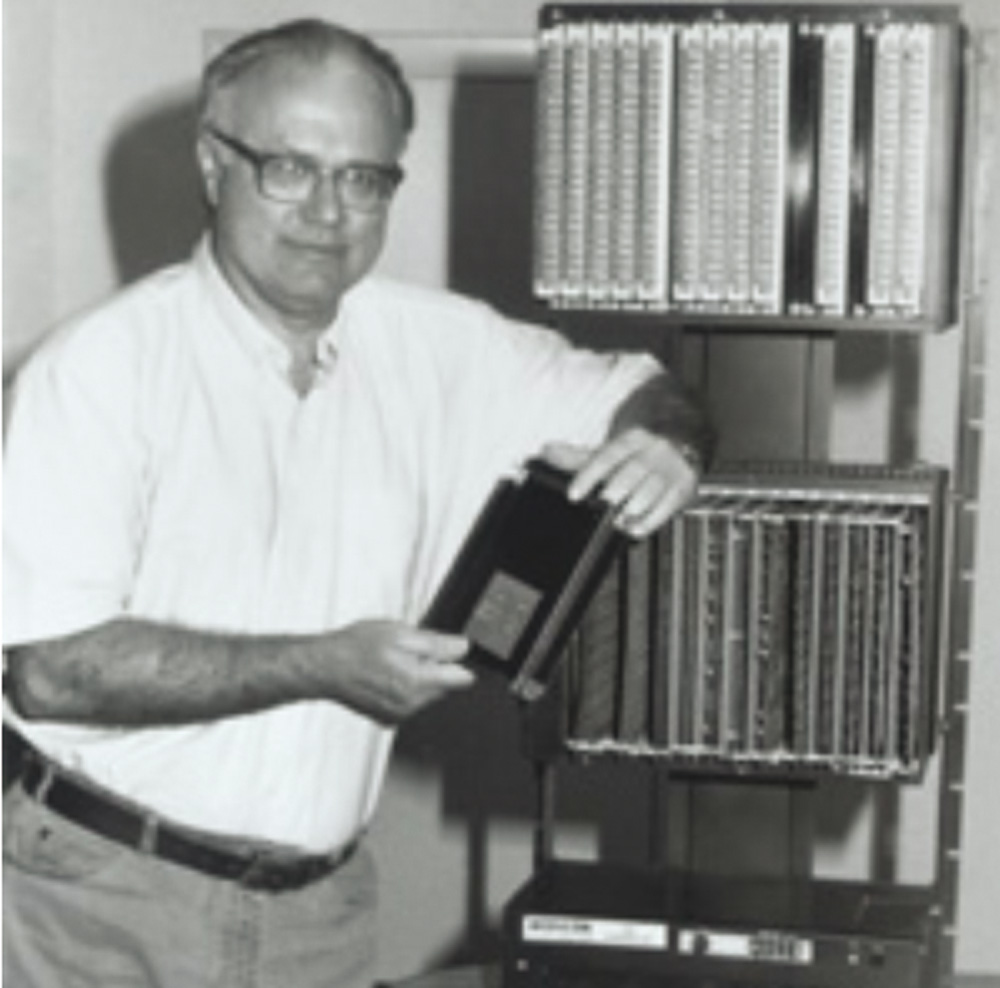History
Visit the PLC museum on this siteThe Programmable Logic Controller (PLC) was conceived by Dick Morley on January 1, 1968. Mr. Morley's PLC, which at the time was called a PC for Programmable Controller and later, after the introduction of the Personal Computer (PC) changed the name to PLC, was produced by his company called Modicon. Modicon stands for MOdular DIgitial CONtroller.
The first PLC was designed to meet the specifications layed out by the Hydramatics Division of General Motors (GM). The primary goal of the design was to eliminate the extremely high cost involved with electromechancial relay switching circuits and the lack of flexiblity associated with these 'hardwired' circuits. Anyone who is old enough to remember American cars during the 1950's and 1960's knows that the styles and options of the cars during this era changed with every model year. These changes meant that every year the car manufacturers had to retool their factories and make major modifications to the automated assembly lines. These changes required weeks of work by teams of engineers, technicians and electricians to rewire the relay control logic and possibly weeks more to troubleshoot and eliminate wiring errors; a very costly venture.
The specifications that GM layed out were:
- The controller had to be solid-state.
- The system had to have the flexibility of a computer system.
- Controllers had to be capabable of surviving an industrial environment.
- Programming had to be easy and be able to be maintained by plant electricians.
- The system had to be reusable.
- Pricing had to be competitive with relay control systems.
- Input and Output (I/O) interfaces had to be easily replaceable.
- A modular design had to be used so that subassemblies could be easily removed, replaced and repaired.
- Manufacturing data needs to be collected and passed on to a central computing system.
- The method of programming should be in the form of relay ladder logic, a method that plant electricians, engineers and technicians were already familiar with.

The first PLC was installed at General Motors Oldsmobile plant and at the Lanids Company in Landis, Pennsylvania in 1970. Mr. Morley is shown at right with the first PLC.
The initial intent of the PLC was to be a reuseable, reprogammable relay replacer. In order for the PLC to be accepted into industry it had to be marketed as a new form of mechanical relay, timer and counter. Industry is always concerned with reliablility and had the PLC been marketed as a computer, industry would have been very reluctant to incorporate them. Presently, the PLC industry is and has been attempting to move away from relay ladder logic programming, but it is finding it difficult to do so as a result of this early marketing strategy.
Since the first PLC was installed in the early '70s they have become much more then simply a relay replacer. Applications for PLCs has extended to a very broad range of manufacturers of all types of products. Users are demanding more features to be added such as:
- subroutines being added to the language.
- perform complex math functions.
- include data handling capabilities
- programmers should be able to program and handle interrupts.
- analog I/O needs to be accepted, processed and output.
- the Proportional Integral Derivative (PID) function needs to be included for process control.
- control should be distributed.
- communications should be capabable between other PLCs, computers and devices on a network.
One problem with adding these new functions and features is that PLC manufacturers have always had proprietary designs with proprietary networks making it next to impossible to communicate with equipment manufactured by various vendors and because the networks were proprietary, PLCs from different vendors could not talk to each other.
The 1980's saw a shift away from the proprietary systems and PLCs, PCs and other equipment started to be capable of working together as a single unit. GM was again a leader in standardization and developed a communications standard called Manufacturing Automation Protocol (MAP). The industry was also reducing the size of PLCs and today some of them are the size of a cigarette pack.
A continuation toward standardization was seen in the 1990s when the International Electrical Commission standard IEC 1131-3 was established to standardize the programming languages. The standard was later changed to IEC 61131. Also during this decade sub-networks such as ControlNet, DeviceNet and Foundation Fieldbus were introduced that further extended the distributive control features and allowed for different vendors to coexist on the same sub-network.
It is difficult to predict the future of PLCs, but with the advent of Programmable Automation Controllers (PACs) in the 21st century it is easy to imagine that PLC/PACs will be approaching PCs in short order. PACs can be programmed using a variety of languages from relay ladder logic, sequencial function chart, block diagram and structured text to C++ and Java or a mixture of all. Ethernet is fast becoming the network of choice and the Internet/IP protocol is already a standard. Many of the networks are becoming wireless and self healing. The future is without bound and PLC/PACs development will surely move forward at an ever increasing rate.
Visit the PLC museum on this site
